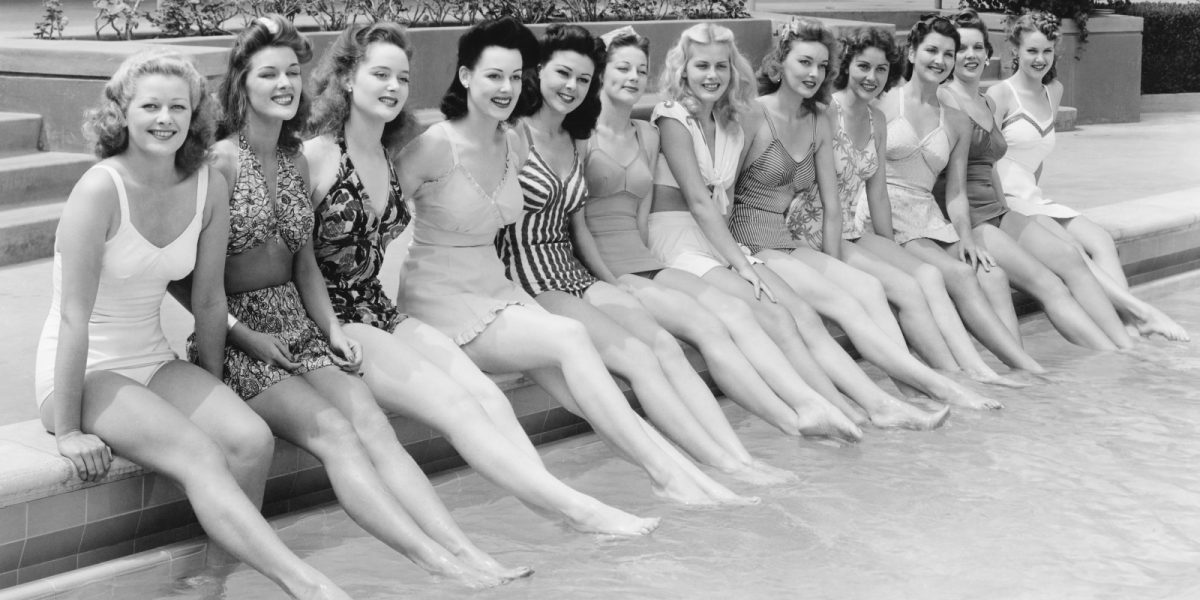The history of swimming costumes shows how fashions in beachwear have changed far beyond the split-level, brief, and bandeau styles that we associate with swimsuits today. History is littered with a variety of swimsuits that you would not be so quick to model on a catwalk. From ancient Greece to early 20th century Western fashion, see the history of bathing costumes and their impact on popular culture and beachwear.
Swimwear in Prehistoric Times
If we could go back in time to prehistoric times, we would probably see early humans swimming to avoid predators or get from one place to another, but there was no “swimwear.” These early swimmers didn’t need any specialized clothing for swimming because they were usually naked anyway, climate permitting.
Swimwear in Ancient Times
In ancient times, we begin to see more clothing worn in the water. In fact, some cultures created specialized garments explicitly designed for swimming, like the Japanese fundoshi (a type of loincloth) that was first seen around 10,000 B.C., and the Greek chiton that was often made from wool or silk and then soaked in water before swimming so it would cling to the body like a wetsuit. The Romans also wore a simple form of bikini when they competed in athletic events at their thermal baths (similar to modern-day hot tubs).
17th Century
Until the 1670s, nude female bathing was the norm at spas in Europe. Bathing costumes for women started appearing in spas, such as those in Bath, England shortly after – as the detailed description of Celia Fiennes in 1687 shows:
“The Ladyes go into the bath with Garments made of a fine yellow canvas, which is stiff and made large with great sleeves like a parson’s gown; the water fills it up so that it is borne off that your shape is not seen, it does not cling close as other linning, which Lookes sadly in the poorer sort that goes in their own linning. The Gentlemen have drawers and wastcoates of the same sort of canvas, this is the best linning, for the bath water will Change any other yellow.”
18th Century
Wool or flannel gowns reaching the wrists and ankles protected the wearer’s modesty in 18th-century European spas.
Although it was still common for men to swim nude or in their underwear in rivers, lakes, streams, and the ocean. There were no laws or dress codes to enforce wearing anything in many places until later in the century.
19th Century
In 1860, men swimming nude in the United Kingdom were banned, and using drawers became commonplace. Women in many European countries favored two-piece outfits, and gradually throughout the century, sleeves started to vanish, and bottoms became shorter.
In the West, women wore ankle-length gowns with weighted hems that didn’t get transparent when wet. Generally speaking, nudity of any kind was despised by Victorian-era Western cultures.
However, late in the 19th century and moving into the 20th century, things began to change. Beauty pageants were initially frowned on, but the advent of “Miss America” in the United States created a platform for showcasing swimwear closer to what we know today.
20th Century
The first modern two-piece suits were introduced in 1913 by the fashion designer Carl Jantzen and his team in the United States. They were designed with wool jersey fabric, a product of recent innovation that clung to the body but allowed free movement. The upper part of the costume was sewn into a pair of shorts, while the bottom part was made into a skirt.
These suits were intended for wear in public places. They became popular with bathers on beaches everywhere and were made in various colors and styles. For example, striped costumes became popular during this period and remained so for many years to come. Many women also wore wool bathing suits with skirts over them for modesty and warmth.
Form-fitting styles were so popular that swimwear continued to shrink despite some opposition, exposing more and more with each passing decade.
The first bikinis appeared just after World War II. Earlier examples exist, but these were one-of-a-kind creations made by designers who did not intend to sell them. In 1946, Louis Réard, a French mechanical engineer who had worked in the fashion industry, introduced a two-piece swimsuit design that he named the “bikini.” His design was a low-cut, sleeveless one-piece swimsuit with a belt tied around the waist. Réard’s swimsuit design was daring compared to the fabric used for designs at this time, and his design was regarded as risqué.
The press immediately dubbed it the bikini because of its supposed resemblance to an atoll where nuclear weapons testing took place, and also because it was named after Bikini Atoll in the Marshall Islands, where nuclear weapons had been tested, although Réard did not claim that his design was inspired by the atomic bomb or bathing suits worn by natives of Bikini Atoll.
The Influence of Olympics on Swimsuits
The Olympics have always been an important event in the swimwear industry. Every four years, the world’s collective attention is on the competitions and athletes, and companies vie for their products to be worn by them.
The 1920s
Women’s swimwear of the 1920s was inspired by the hemlines of the day: short in front with a longer train in the back (known as a hobble skirt). The French designer Madeleine Vionnet offered up a ‘bathing dress’ in 1923 that she described as “a tunic drawn through the legs.” The stockings were attached to a one-piece bathing suit. The style became so popular that Vionnet was forced to open a beach resort named after her best-selling design.
The 1930s
The 1930s are known as the golden age of Hollywood when the great movie houses were in their prime. It was also when cinema began to recognize and embrace the sex appeal of a woman in a swimsuit. The emergence of swimwear as a fashion item at this time is credited to French designer Jacques Heim. His design was simple: two small triangles of fabric connected by string. The microkini was born.
The 1940s, 50s, 60s, 70s, and 80s
The 1940s. Before World War II, women’s swimsuits were typically made of wool and covered their arms and legs. After the war, bathing suits became skimpier, but they still weren’t bikinis — think high-waisted bottoms and halter tops.
The 1950s. This was when the bikini was born. The style emerged in France in 1946, and it was an almost immediate hit – except with many Americans, who thought it was too risqué for women to wear such a skimpy suit to public beaches or pools. But over the next few years, the bikini slowly gained mainstream acceptance (along with the rising hemlines of women’s skirts on land).
The 1960s. It wasn’t until the late 1960s that American women began wearing what we now consider standard bikinis – two triangles of fabric covering only their essentials.
The history of swimwear is long, stretching back to the earliest societies that swam in fresh and saltwater rivers and beaches. As with most things, the origins of swimsuits were not intended as an expression of beauty but rather as a practical means of swimming and keeping warm while doing so. They were created through various methods, from sewing animal hides together to weaving plant fabrics into something wearable and protective from the elements.







